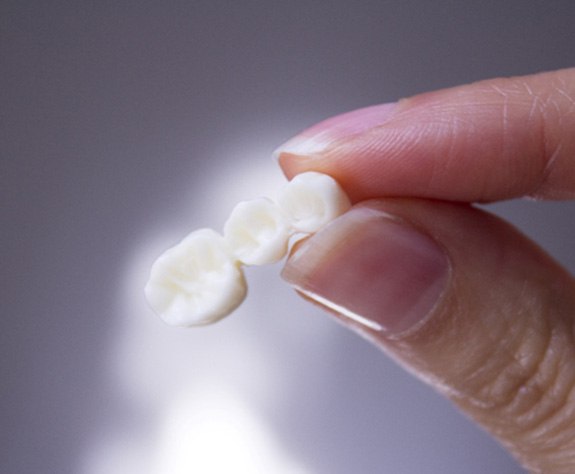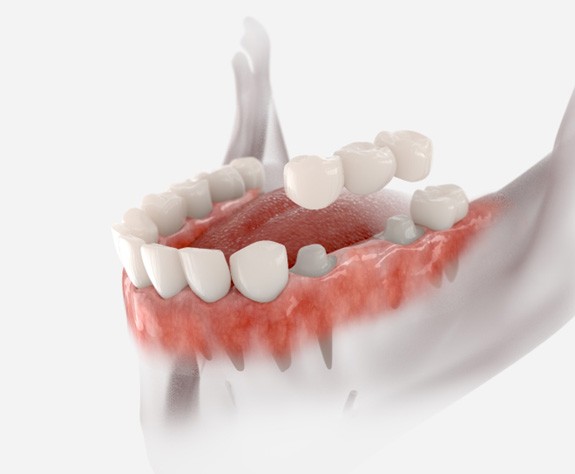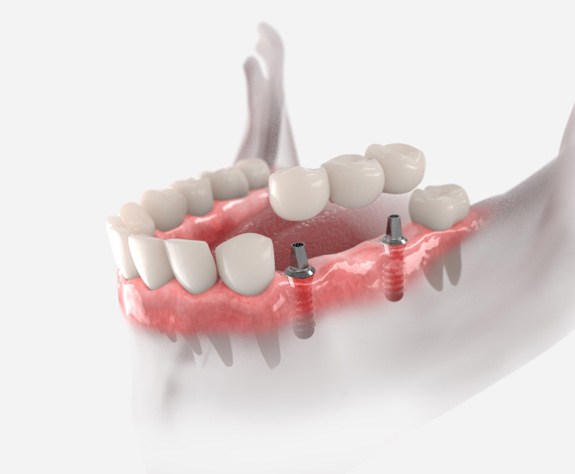Dental Bridges — Raleigh, NC
A Complete Smile Is in Your Future
Even just one missing tooth can cause a lot of problems when it comes to eating, speaking, and just feeling good about yourself when you smile. And while these daily struggles shouldn’t be overlooked, the long-term issues that come from an unwanted gap can’t be ignored as well (an increased risk of gum disease and the teeth shifting to become misaligned). Fortunately, the team at Lake Boone Dentistry Raleigh can solve this problem using a proven solution — dental bridges. Whether you have a single missing tooth or a few in a row, getting your complete smile back is easier than you might think. Contact us today to learn more about your options.
Why Choose Lake Boone Dentistry Raleigh for Dental Bridges?
- Custom Designed for Each Patient
- Dentists Have Placed Thousands of Bridges
- Warm & Friendly Atmosphere
What Is a Dental Bridge?

A dental bridge is a type of prosthetic that gets its name from the fact that it literally bridges the space left by one to three missing teeth in a row. Crowns are placed on the teeth on either side of the gap, and these are used to support additional crowns that serve as the new teeth in the middle, also called pontics. Bridges are highly customizable and can be fabricated in a way that they seamlessly blend in with a patient’s natural smile.
Types of Dental Bridges

To give our patients as many care options as possible, we offer two distinct types of bridges that can each accomplish the same goal, but in slightly different ways.
Traditional Dental Bridge

Traditional dental bridges work like we touched on above—a series of dental crowns is bonded together to replace any missing teeth. While there have certainly been improvements over the years, this tried-and-true method has been trusted for decades, and it offers a relatively simple, fast, and reliable way to bring back missing teeth.
Implant Bridge

Rather than having the bridge be supported by dental crowns placed over natural teeth, instead, two dental implants are positioned on either side of the space. These are then topped with crowns, and they provide the structure needed to hold the pontics. Implant crowns tend to be more stable and longer lasting than traditional ones, plus they allow our team to preserve more of your natural enamel during placement.
The Benefits of Getting a Dental Bridge

- Lowers the risk of future tooth loss dark
- Prevents the nearby teeth from moving out of place
- Makes it easier to speak and eat normally
- Creates a full, confident smile
- Protects the gums from infection or pressure from chewing
- Prevents the remaining teeth from wearing prematurely
- Stops bone loss in the area (implant bridge only)
Dental Bridges FAQs

With dental bridges, you’ll be able to replace one or three teeth in a row for a long-lasting solution. Still, it’s normal to have concerns and questions about the procedure and what to expect from your results before moving forward with the process. The good news is that we’ve taken the time to compile some of the frequently asked questions about dental bridges from our patients in Raleigh. Read on to learn more or give us a call to schedule your consultation.
Do Dental Bridges Feel Natural?
When you first receive your dental bridges, it’ll take some time to get accustomed to having them in your mouth. However, after several days of using them, they should begin to feel increasingly more natural. The best part about them is that they are durable enough to withstand the pressures of everyday chewing similar to your natural tooth enamel, so you shouldn’t have any problems when eating. Furthermore, your bridge will be specifically designed to fit your unique smile, so you should expect a natural feeling bite while chewing and talking.
Is Getting a Dental Bridge Painful?
At the start of your procedure, your dentist will ensure that your mouth is completely numbed with a local anesthetic so that you remain pain-free throughout your visit. This means you shouldn’t feel any discomfort during the process itself. Once your tooth has been prepared and some of your enamel is removed, you might expect slight soreness and sensitivity for the following few days. Fortunately, this can easily be alleviated with over-the-counter or prescribed pain relievers. Should any discomfort persist or worsen, be sure to reach out to us for help. Additionally, dental bridges prevent other teeth from shifting out of place, so they can end up helping you avoid discomfort in the future.
Can Dental Bridges Get Cavities?
Although they’ll appear similar to your natural pearly whites, dental bridges are not made out of organic material. This makes it impossible for them to develop cavities. Even so, this doesn’t mean your natural teeth and gums are immune to complications. Without proper care, the rest of your smile can still accumulate food particles, bacteria, and plaque, placing you at risk of decay, cavities, and infection. Your gumline underneath your restoration will also need to be cleaned regularly, otherwise, you’ll have an increased chance of developing gum disease. Remember to clean your smile every day and visit your dentist twice a year for checkups and cleanings.
How Many Teeth Can a Dental Bridge Replace?
Based on a person’s needs, dental bridges can help replace around one to four consecutively missing teeth. That said, in most situations, your dentist might only recommend using this restoration treatment to renew one or two pearly whites. This is because a longer bridge can risk becoming unstable the further it extends. For optimal stability and a longer-lasting solution, you’ll want to consider consulting your dentist about implant bridges.
